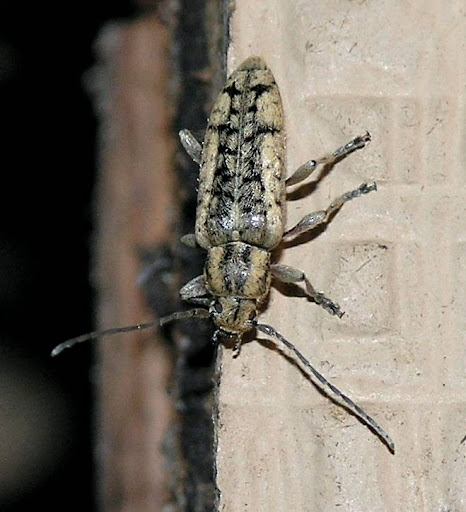Small Cedar-bark Borer Beetle - Atimia confusa
(Photo: Marvin Smith on 3/9/09)
I found limited information about this relatively small (6-9 mm) Longhorned Beetle. According to BugGuide, Atimia confusa is widespread throughout the central and eastern U. S., is active in the spring and fall and is attracted to lights. (I photographed this specimen under our porch light.) Larval host plants are cedars and junipers.
.

This little beetle has an intricate pattern on its back. A handsome bug. I wonder if it does as much damage as the pine bark beetle??
ReplyDeleteHe may be tiny, but he's pretty ominous looking!
ReplyDeleteFerocious looking beast, glad the photo is larger-than-life-size! You take photos of the most interesting stuff around your house and yard.
ReplyDeleteI love the patterns on this one Marvin.
ReplyDeleteLisa: Judging by the lack of information on this critter, I doubt it's a significant agricultural pest like the pine bark beetle.
ReplyDeleteKaHolly: Some Longhorned Beetle are a lot larger and not nearly as cute as this one.
ReplyDeleteWren: All the different flora and fauna that can be found on one modest sized plot of land is pretty amazing when you stop and think about it.
ReplyDeleteJoan: The pattern was the first thing that caught my eye. I didn't remember having seen this species before.
ReplyDeleteI like this beetle's appearance!
ReplyDeleteBy the way, Marvin, thanks! I should have known somewhere on the internet would be a phrase finder! (referring to my question about your phrase "Now I know for whom the chimes toll; they toll for thee")
Pretty, although that can't bode very well for the cedars & junipers!
ReplyDeleteJeannette: I often have a phrase or phrase fragment bouncing around in my head. The various quote sites on the Net come in handy.
ReplyDeleteLana: I have never noticed the larvae of these beetles at work so I don't think the damage they do is severe. The only host species we have on our place are red cedars which are an invasive species here anyway.
ReplyDeleteThese little borers can cause so many problems. We are on the watch for the emerald ash borer which will decimate the ash trees here in NY.. another non-native introduced pest.. Michelle
ReplyDeleteMichelle: Usually native borer species in a natural environment don't get out of control. Alien species or monoculture situations are a different matter.
ReplyDeleteI really enjoy your bug photos. I haven't gotten as many bugs in New Hampshire as Vermont (why? I have no idea!)And we both use bugguide.
ReplyDeleteI did get a locust borer, tho. Way different than your cedar borer here.
The photo is stunning.